

MPLS - The Internet Protocol Journal - Volume 4, Number 3. Multiprotocol Label Switching (MPLS) is a promising effort to provide the kind of traffic management and connection-oriented Quality of Service (QoS) support found in Asynchronous Transfer Mode (ATM) networks, to speed up the IP packet-forwarding process, and to retain the flexibility of an IP-based networking approach.
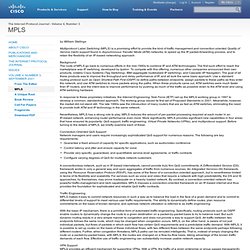
The roots of MPLS go back to numerous efforts in the mid-1990s to combine IP and ATM technologies. The first such effort to reach the marketplace was IP switching, developed by Ipsilon. To compete with this offering, numerous other companies announced their own products, notably Cisco Systems (Tag Switching), IBM (aggregate routebased IP switching), and Cascade (IP Navigator). In response to these proprietary initiatives, the Internet Engineering Task Force (IETF) set up the MPLS working group in 1997 to develop a common, standardized approach. The working group issued its first set of Proposed Standards in 2001. Nevertheless, MPLS has a strong role to play. MPLS and IP. What is Multiprotocol Label Switching (MPLS)? - Definition from Whatis.com. Frequently Asked Questions. What is MPLS VPN ?
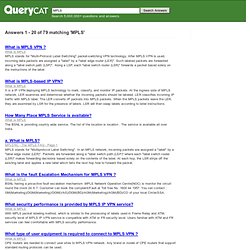
MPLS stands for "Multi-Protocol Label Switching" packet-switching VPN technology. After MPLS VPN is used, incoming data packets are assigned a "label" by a "label edge router (LER)". Such labeled packets are forwarded along a "label switch path (LSP)". Along a LSP, each "label switch router (LSR)" forwards a packet based solely on the instructions of the label. CISCO-MPLS-Concept.pdf (application/pdf Object) Multiprotocol Label Switching.
Multiprotocol Label Switching (MPLS) is a mechanism in high-performance telecommunications networks that directs data from one network node to the next based on short path labels rather than long network addresses, avoiding complex lookups in a routing table.
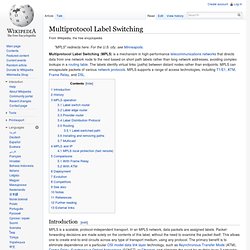
The labels identify virtual links (paths) between distant nodes rather than endpoints. MPLS can encapsulate packets of various network protocols. MPLS supports a range of access technologies, including T1/E1, ATM, Frame Relay, and DSL. Introduction[edit] Different between MPLS IPLC. Q&A: IPLC & MPLS. Vs MPLS/IPLC links. How is IPLC & MPLS VPN different? are the two competing data connectivity options? How much a Delhi-London IPLC link cost? What would be comparable MPLS pricing?
Difference between MPLS & IPLC. Multiprotocol Label Switching. Multiprotocol Label Switching (MPLS) is a mechanism in high-performance telecommunications networks that directs data from one network node to the next based on short path labels rather than long network addresses, avoiding complex lookups in a routing table.

The labels identify virtual links (paths) between distant nodes rather than endpoints. MPLS can encapsulate packets of various network protocols. MPLS supports a range of access technologies, including T1/E1, ATM, Frame Relay, and DSL. Introduction[edit] MPLS is a scalable, protocol-independent transport. In particular, MPLS dispenses with the cell-switching and signaling-protocol baggage of ATM. At the same time, MPLS attempts to preserve the traffic engineering and out-of-band control that made Frame Relay and ATM attractive for deploying large-scale networks.
History[edit] Catalyst 6500 Release 12.2SX Software Configuration Guide - STP and MST [Cisco Catalyst 6500 Series Switches. Table Of Contents Configuring STP and MST Understanding STP STP Overview Understanding the Bridge ID Bridge Priority Value Extended System ID STP MAC Address Allocation Understanding Bridge Protocol Data Units Election of the Root Bridge STP Protocol Timers Creating the Spanning Tree Topology STP Port States STP Port State Overview Blocking State Listening State Learning State Forwarding State Disabled State STP and IEEE 802.1Q Trunks Understanding IEEE 802.1w RSTP Port Roles and the Active Topology.
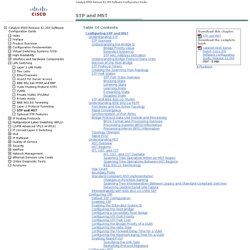
Catalyst 6500 Release 12.2SX Software Configuration Guide - STP and MST [Cisco Catalyst 6500 Series Switches. Table Of Contents.
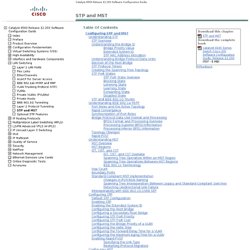
Catalyst 6500 Release 12.2SX Software Configuration Guide - STP and MST [Cisco Catalyst 6500 Series Switches. MSTP Configuration - Multiple Spanning Tree Protocol. MSTP short for Multiple Spanning Tree Protocol is an IEEE standard was inspired by Cisco Multiple Instances Spanning Tree Protocol.

In MSTP, you can create a multiple groups for different types of VLANs and then run single instance of spanning tree for a single group of VLANs. But in traditional PVST, there is a different instance of spanning tree for each VLAN. Single instance for a group of VLANs reduce the number of BPDUs, root bridges and root ports in the network. You can perform a proper load balancing across redundant links using MSTP group instances.
Today tip will help you to configure Multiple Spanning Tree Protocol for different VLANS using three switches. Follow the network topology of three switches to manage the group of VLANS in given figure: Cisco mstp vs ip. Cisco msp vs ip. Aspire CCNA Edition, CCNA game - The Cisco Learning Network Store. 360 Learning Program Enhancements. What is new In the Cisco Expert-Level Training for the CCIE Routing and Switching v5.0 update?
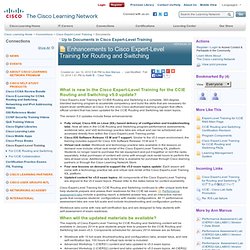
Cisco Expert-Level Training for CCIE® Routing and Switching is a complete, 360-degree, blended learning program to accelerate competency and build the skills that are necessary for expert-level certification at Cisco. It is the only Cisco-authorized learning program that offers official content that has been updated for the CCIE Routing and Switching lab exam topics. The version 5.0 updates include these enhancements: Cisco Expert-Level Training for CCIE Routing and Switching continues to offer unique tools that help students prepare and assess their readiness for the CCIE lab exam.
Performance assessment labs include a grading report, a detailed answer key, and an interactive mentor guide that compares students’ configurations with master configurations. Workbook labs come with new self-verification tips and are designed to help students with self-assessment of exam readiness. E-Service Training.
Cisco Learning Network. Networking Academy. Training & Events.